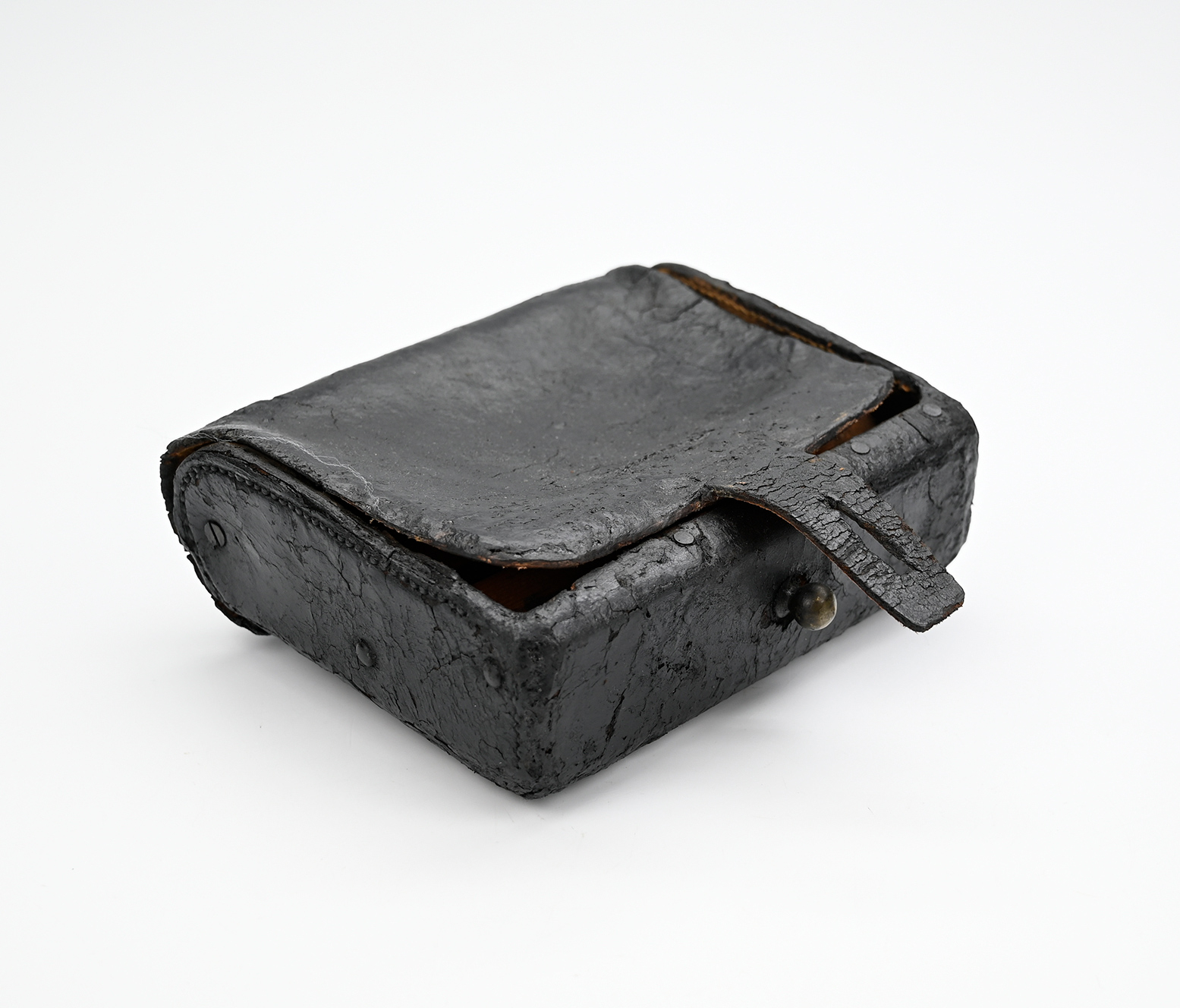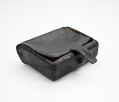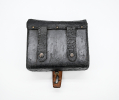site search
online catalog
SCARCE MERRILL CARTRIDGE BOX

$1,895.00
Quantity Available: 1
Item Code: 490-5258
Shipping: Determined by Method & Location of buyer
To Order:
Call 717-334-0347,
Fax 717-334-5016, or E-mail
This is a scarce Merrill cartridge box supplied by the company to the US government along with its rifles and carbines during the Civil War. Paul Johnson believed they were delivered with all carbines and McAuley quotes a March 22, 1862, order for rifles that includes cartridge boxes as well. Johnson illustrates the same pattern box with the same marking stenciled in black on the inside of the flap, “MERRILL PATENT / FIRE ARMS / MFG CO / Patent Applied for / BALTIMORE,” and dates the box after the company’s change of name from Merrill, Thomas and Company in July 1863, and thus thinks it was delivered with the company’s last two arms contracts of August 1863 and June 1864, which totaled 4,100 carbines, with the last delivered in July 1864, though we might also place it in the July 1863 deliveries of 1,000 carbines.
James Merrill of Baltimore had been involved in the small arms business since the 1840s and supplied carbines to the U.S. government as part of Merrill, Latrobe and Thomas in the 1850s. He was also involved in altering Jenks carbines, M1841 rifles, and M1842 muskets to his breechloading system. During the war he supplied some 14,225 carbines and 770 rifles to the U.S. government, with the first deliveries in Fall 1861 and the last in Summer 1864. Among the cavalry regiments armed with Merrill carbines, both first and second models, were the 1st, 5th, 8th and 18th NY; 11th, 17th and 18th PA; 1st NJ; 7th IN, and 3rd MI. Among infantry outfits getting the rifle was the 21st Indiana. A soldier of the 83rd Illinois is also shown not only with a Merrill carbine, but wearing a Merrill cartridge box. Although an infantry outfit, some of its men were converted to mounted infantry in July 1863 to deal with guerillas.
The box is made of black leather and features a four-tiered or stepped wood block bored to hold 28 cartridges, 7 in each tier. It is designed for wear on a waistbelt only, with two belt loops, stitched and riveted on the back. The bottom has a typical, brass ball-shaped finial to secure the latch tab, which is sewn to the inside of the flap with two rows of stitching in an eye shape. Aside from the rivets on the bottoms of the belt loops, the leather elements are sewn together, and secured to the wood block with three brads along the upper back edge, with two more on each side with a screw at the very top. The box very likely had an inner flap with attached implement pouch, as shown in Johnson’s illustrations, that is now missing.
Johnson’s dating of the box is certainly correct, puts it in the field in time for use in many of the significant campaigns and larger cavalry operations of the war, and is supported by the existence of boxes stenciled with the earlier company name: “Merrill, Thomas & Co./ Baltimore/ Patent Applied For,” using sewn belt loops without rivet reinforcement, an earlier pattern. Interestingly, both his earlier and later boxes are marked only “patent applied for,” not “patented.” The answer may lie in the suspiciously similar G. Jassath Sept. 17, 1861, patent cartridge box. His design used a the same stepped or tier arrangement for holding cartridges, all of which would be exposed by lifting the lid/cover. His patent mentioned the use of sheet metal and metal tubes for the cartridges, but extant examples show the use of a wood block bored out for cartridges just like the Merrill marked boxes and his patent specified sheet metal “or other proper material,” so Merrill’s efforts, if he pursued the patent, were likely to go nowhere.
Known Jassath boxes seem to have been marketed to officers, being covered in high grade leather and bored for .32 Cal. cartridges suggesting they were intended for metallic cartridges for the S&W No.2 Army and the like. This would make up for the major fault of the design, which was hardly water-resistant let alone waterproof. This would be a major problem for the Merrill paper cartridges and one that he tried to solve in the early version of the box by attaching side ears to the flap that were round at the top and then tapered toward the bottom, running most of the way down the flap to close the sides as well as top of the main compartment. It is possible this improvement was the actual basis for his patent application. In any event, these would likely have torn out sooner or later from the stress of pulling up the flap, so it is not surprising they seem to have been omitted in the later pattern: neither this box nor the one illustrated by Johnson seems to have had the side ears. Whether anyone in authority paid attention to the defect or the patent issues seems doubtful.
The box is in solid shape, displayable and given the extensive use of the Merrill would be good and tough-to-find addition to a cavalry or carbine display. The latch tab, finial, and belt loops are in place. The surface of the leather shows wrinkling and some bends with cracking and crazing to the finish and some roughness to one edge of the flap, but no large areas of finish loss, all very much like it saw some active campaigning, which we think is rather a plus. The Merrill stencil is legible, showing just some rubs and a little light on the “MFG CO” third line. [sr] [ph:m]
~~~~~~~~~~~~~~~~~~~~~~~~~~~~~~~~~~~
THIS ITEM, AS WITH ALL OTHER ITEMS AVAILABLE ON OUR WEB SITE,
MAY BE PURCHASED THROUGH OUR LAYAWAY PROGRAM.
CLICK HERE FOR OUR POLICIES AND TERMS.
THANK YOU!
Inquire About SCARCE MERRILL CARTRIDGE BOX
For inquiries, please email us at [email protected]
Most Popular
Historical Firearms Stolen From The National Civil War Museum In Harrisburg, Pa »
Theft From Gravesite Of Gen. John Reynolds »
Cavalry Carbine Sling Swivel »
Fine Condition Brass Infantry Bugle Insignia »
featured item
VERY RARE RICHMOND CLOTHING BUREAU / RICHMOND DEPOT ARTILLERY ENLISTED MAN’S CAP
Formerly in the collections of the Texas Civil War Museum, this Confederate artilleryman’s cap is discussed and illustrated as Figures 052a-c in Fred Adophus’s excellent article: “The Quintessential Confederate Cap, Part II: Caps of the… (1179-409). Learn More »












